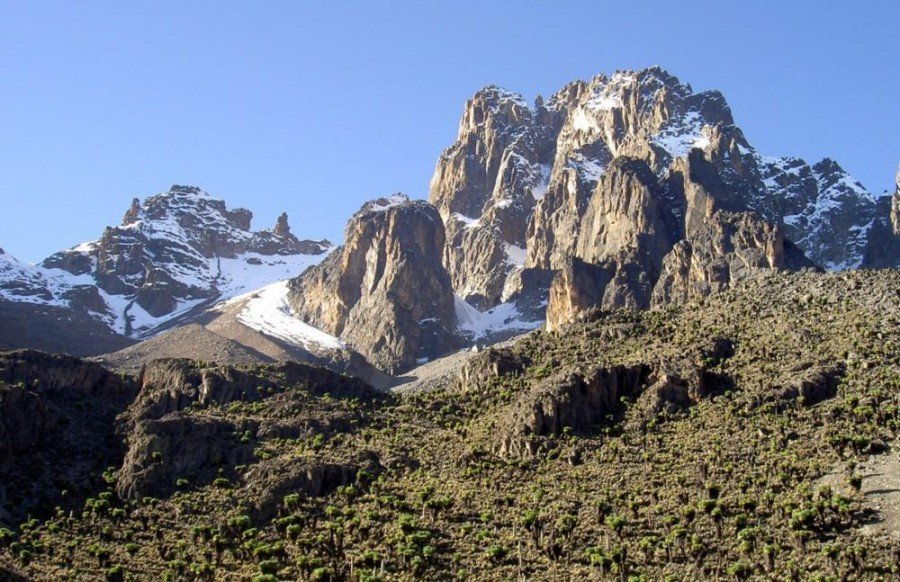Mount Kenya National Park Kenya
Mount Kenya National Park -Located 175km northeast of the capital Nairobi, the mountain of brightness as referred to by Kenyans is one of the most impressive landscapes in Eastern Africa with rugged glacier-clad summits, Afro-alpine moorlands, and a variety of forests that demonstrate its unparalleled ecological processes.

Established in 1949, the park covers an area of about 715 square kilometers and stands over just 5000m. Initially a forest reserve, the park currently is encircled by the forest reserve and was designated a UNESCO Biosphere Reserve in April 1978 and later a World Heritage Site in 1997 when the park and reserve were combined to protect Mount Kenya, its flora and fauna as well as other ecosystems which keep life in it thriving. It is the highest mountain in Kenya and second in Africa after Mount Kilimanjaro. This stunning mountain is a dormant volcano and the major water source to about 50% of the population, also contributing about 65% of Kenya’s hydroelectric power.
Mountain Kenya served as a throne on earth for Ngai, the god of the Kikuyu people who live on the Southern and Western sides of the mountain.
Mount Kenya has three main peaks; Batian, Nelion, and Lenana. The former being the highest and highly technical which makes them rarely climbed compared to Point Lenana which is a trekking point. Other peaks on the jagged landscape include Coryndon, Piggot, Dutton, and John presenting interesting rock climbs.
Statistics show that about 15,000 people climb Mount Kenya yearly and the biggest percentage of this goes to Lenana peak at 4,985 meters because of the ease of reach. The two other higher peaks attract only a few hundred climbers.
The three main routes used to climb are Naro Moru to the West, Sirimon on the North West, and Chogoria on the South catering for 90% of all trekkers visiting this stunning snow-capped landform.
When to Climb Mount Kenya
Due to the mountains’ unique position on the equator, June through to August (During the Northern hemisphere summer) when the sun is slightly North means there is less ice and snowmaking climbing easy through the North Face route although September and early October offer a possibility too.
The southeast Face provides easy access to the Nelion and Batian through the Gates of Mist.
Accessing the Mount Kenya National Park
Access to the park by road is good with an estimated drive time of 4 hours through a good road from Nairobi using the Nanyuki-Isiolo road. This passes through the Sirimon track or using Nyeri-Nanyuki road close to Naro Moru. Other access points are Chogoria through the Embu-Meru road, which takes approximately 2 and a half hours north of Nairobi. There are also many other public taxis and shuttles that traverse this route daily to the Mt. Kenya area.
Wildlife in the Mount Kenya National Park
While in Mount Kenya National Park, you will be able to see animals which include elands, elephants, waterbucks, black-fronted duiker, tree hyrax, bushbucks, white-tailed mongoose, cape buffalos, dik-dik, and mole rats.
The park also hosts a number of captivating high-altitude vegetation including lobelias and giant groundsels.
Rare sightings include the leopard, bongo, and giant forest hog.
Bird watching
The park is a refuge for over 130 species of birds. Due to its montane avifauna, most of these are forest birds. Some of these include bronze-naped pigeon, Ayres hawk-eagle, red-headed parrot, mountain Buzzard, Jackson’s Francolin, slender-billed starling, black-headed waxbill.
Accommodation in Mount Kenya National Park
For a full-time experience at the park, choose a lodge within reach of the park. The park offers accommodation options that suit both your tastes, travel style, and budget. Luxury options include Serena Mountain Lodge, Fair Mount Kenya Safari Club. Other lodges where you can book from include Bessoted Farmstay, The Wonky House, Ngomogo, Mount Kenya Villas, and Eco-Camp.


